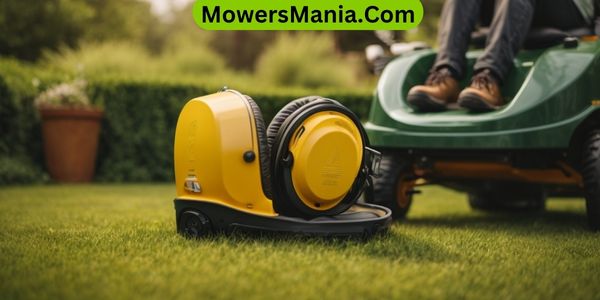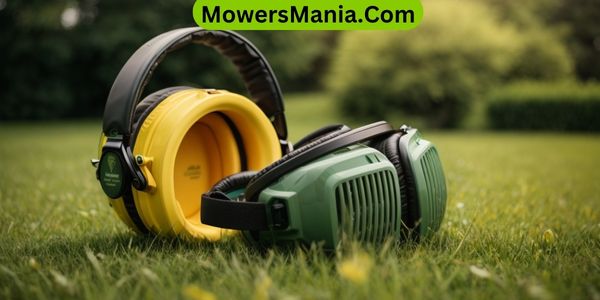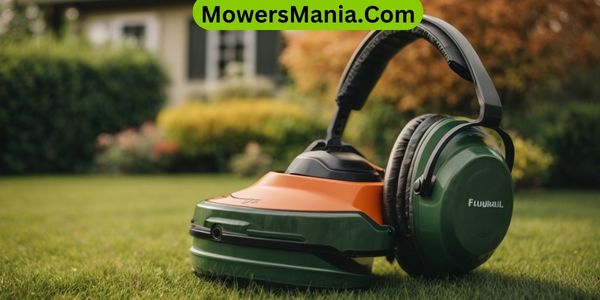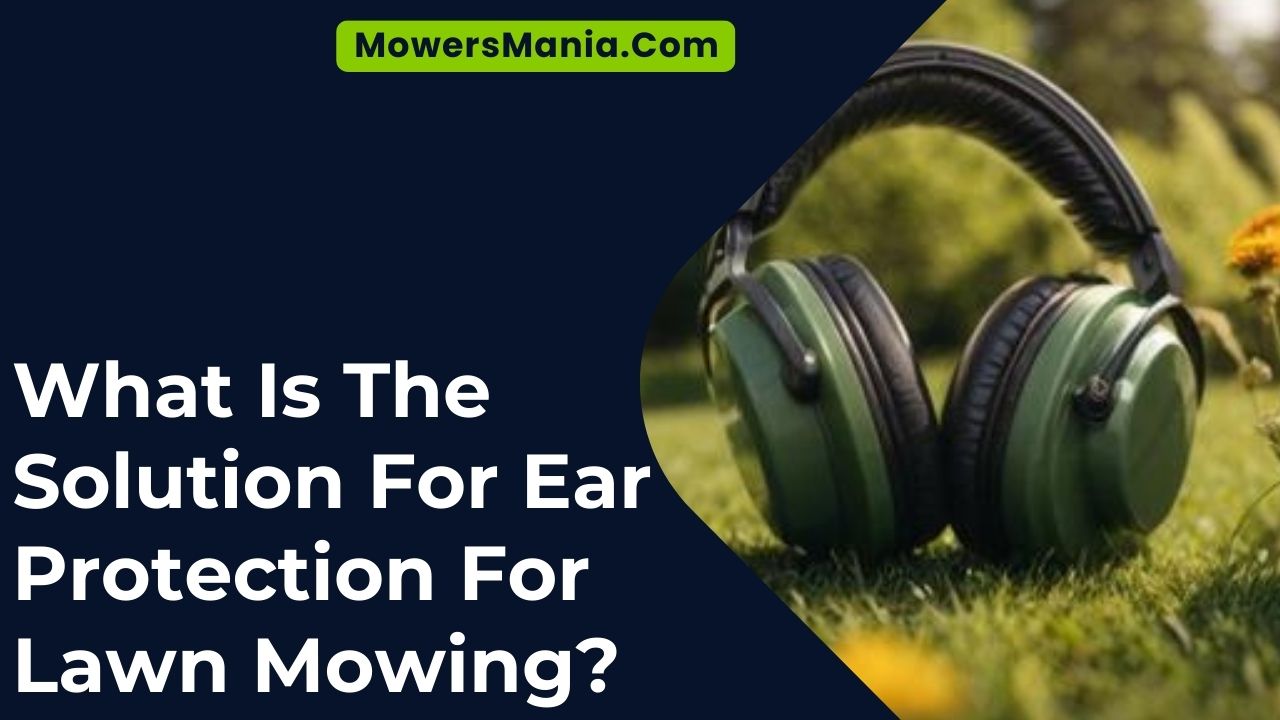You need to protect your ears while mowing the lawn. Loud noise can cause permanent damage, but there’s a solution.
In this article, you’ll discover the importance of ear protection, different types available, and factors to consider when choosing the right one.

You’ll also learn tips for a proper fit and how to maintain and care for your ear protection. Stay safe and keep your hearing intact while enjoying your yard work.
Importance of Ear Protection
Prioritize your hearing by understanding the significance of ear protection when operating loud lawn mowing equipment.
The noise from a typical gas-powered lawn mower can reach up to 100 decibels, which is well above the safe level for prolonged exposure. Without proper ear protection, this level of noise can cause damage to your hearing over time.
The delicate structures in your inner ear can be irreversibly harmed by prolonged exposure to loud noise, leading to hearing loss and other potential issues. By wearing ear protection, such as earmuffs or earplugs, you can significantly reduce the risk of hearing damage while operating loud lawn mowing equipment.
It’s crucial to recognize that the effects of noise-induced hearing loss are cumulative and may not be immediately noticeable. Over time, the damage can become permanent, impacting your ability to hear and communicate effectively.
Investing in high-quality ear protection is a simple yet effective way to safeguard your hearing and prevent potential long-term consequences. Don’t underestimate the importance of protecting your ears when mowing the lawn, as this small precaution can make a significant difference in preserving your hearing for years to come.
Types of Ear Protection
When mowing the lawn, you can effectively protect your hearing by using earmuffs or earplugs, which are essential for reducing the risk of long-term damage caused by the loud noise of lawn mowing equipment.
Here are the types of ear protection you can consider:
- Earmuffs: These are easy to use and provide a good seal around the ears, blocking out a significant amount of noise. They’re typically adjustable and can fit different head sizes comfortably.
- Earplugs: These are small inserts that fit into the ear canal. They’re lightweight and portable, making them convenient for lawn mowing. Some earplugs are disposable, while others are reusable and can be easily cleaned.
- Noise-canceling headphones: These electronic earmuffs use active noise control to reduce the level of noise that reaches the ears. They’re especially effective in environments with consistent noise levels, such as lawn mowing.
- Custom-molded earplugs: These are individually molded to fit your ear canal perfectly, providing a high level of comfort and noise reduction. They’re often made of silicone or acrylic material and can be a long-lasting and effective option for ear protection.
Factors to Consider
When choosing ear protection for lawn mowing, consider the noise reduction options available.
Look for options that offer a comfortable and secure fit, ensuring that you can wear them for extended periods without discomfort.
Additionally, consider the durability and maintenance requirements to ensure that your ear protection will last and remain effective over time.
Noise Reduction Options
Consider the effectiveness of noise reduction options when choosing ear protection for lawn mowing. Not all ear protection options offer the same level of noise reduction, so it’s important to weigh your choices carefully.
Here are some factors to consider:
- Noise Reduction Rating (NRR): Look for ear protection with a high NRR, as it indicates better noise reduction.
- Fit and Comfort: Ensure the ear protection fits well and is comfortable to wear for extended periods to maximize its effectiveness.
- Type of Protection: Decide between earmuffs or earplugs based on your personal preference and the level of noise reduction required.
- Additional Features: Consider additional features such as Bluetooth connectivity or built-in communication systems if these are important to you.
Comfort and Fit
To ensure maximum effectiveness, prioritize comfort and fit when choosing ear protection for lawn mowing, as a well-fitted and comfortable option will enhance your overall experience and noise reduction. When considering comfort and fit, there are several factors to take into account.
The table below outlines these factors and why they are important for your ear protection:
| Factor | Importance | Considerations |
|---|---|---|
| Earcup Padding | High | Opt for thick and soft padding for long-term comfort |
| Adjustable Headband | High | Ensures a secure and customized fit for different head sizes |
| Weight | Medium | Lighter options reduce strain during extended use |
| Ear Canal Seals | High | Proper seals help in noise reduction and comfort |
Durability and Maintenance
How frequently should you replace the ear protection for lawn mowing to ensure optimal durability and maintenance?
Consider these factors to ensure your ear protection is in good condition:
- Frequency of Use: If you use your ear protection frequently, it may experience more wear and tear, necessitating more frequent replacements.
- Material Quality: High-quality materials may last longer, reducing the frequency of replacements.
- Maintenance: Regular cleaning and proper storage can extend the lifespan of your ear protection.
- Manufacturer’s Recommendations: Some ear protection products come with specific guidelines for replacement based on usage and environmental factors.
Tips for Proper Fit

When it comes to ear protection for lawn mowing, choosing the correct earplugs is crucial. Ensuring a snug earcup fit is also essential for maximum effectiveness.
Comfort is important, but it shouldn’t compromise the overall effectiveness of the ear protection.
Choosing Correct Earplugs
Ensure that you have selected earplugs that fit snugly and comfortably in your ears to provide maximum protection while mowing the lawn.
When choosing the correct earplugs, consider the following tips for proper fit:
- Material: Opt for earplugs made of soft, pliable foam or silicone for a comfortable fit.
- Size: Select earplugs in a size that fits your ear canal snugly without causing discomfort.
- Insertion: Roll the earplug into a small, thin cylinder and insert it into your ear canal while gently pulling the ear up and back to ensure a proper seal.
- Seal Check: After inserting the earplugs, perform a seal check by cupping your hands over your ears and listening for any reduction in noise.
Following these tips will help ensure that your earplugs provide effective protection while mowing the lawn.
Ensuring Snug Earcup Fit
To ensure maximum protection, position the earcup snugly over your ear canal and adjust the headband for a secure fit. Make sure the earcup completely covers your ear and forms a tight seal. If your earmuffs have cushioned earcups, ensure they create a comfortable yet firm seal around your ears.
Adjust the headband so it sits snugly on the top of your head, without being too tight or too loose. Check that the earcup fit is even on both sides and that there are no gaps where sound could leak in.
Proper earcup fit is essential for effective noise reduction, so take the time to adjust the earmuffs until they feel secure and comfortable on your ears.
Comfort and Effectiveness
Adjust the headband and earcups until they form a snug and secure fit to maximize comfort and effectiveness in reducing noise while mowing. Properly fitted ear protection is crucial for both comfort and effectiveness.
Here are some tips for achieving the best fit:
- Headband: Ensure the headband is adjusted to fit securely but not too tightly. It should rest comfortably on the top of your head without causing any pressure points.
- Earcups: Position the earcups over your ears, ensuring they completely cover the ears without gaps. The cushions should form a tight seal against your head to block out as much noise as possible.
- Adjustment: If your ear protection has adjustable features, such as swiveling earcups or a customizable headband, take the time to adjust them to fit your specific head shape and size.
- Comfort: While ensuring a snug fit, also prioritize overall comfort. Discomfort or pain can be signs of an improper fit, so make adjustments as needed to achieve both comfort and effectiveness.
Maintenance and Care
Regularly clean and inspect your ear protection equipment to ensure proper functioning and maximum effectiveness.
After each use, wipe down the ear muffs or earplugs with a damp cloth to remove any dirt, sweat, or debris that may have accumulated.
Check for any signs of wear and tear, such as cracks in the ear cups or fraying of the headband. If you notice any damage, it’s important to address it immediately to maintain the integrity of the protection.
Additionally, for ear muffs, make sure the cushions are still pliable and provide a good seal around your ears. Replace any worn-out or damaged parts according to the manufacturer’s recommendations.
Store your ear protection in a clean and dry environment to prevent mold or mildew growth, which can compromise the effectiveness of the equipment.
Proper maintenance will ensure that your ear protection continues to offer the necessary level of sound insulation and protection for your ears while mowing the lawn.
Ear Protection Proper Maintenance

Ensuring proper maintenance of your ear protection is crucial for maintaining its effectiveness and protecting your ears while mowing the lawn.
By following these simple steps, you can ensure that your ear protection continues to serve its purpose and keep your ears safe:
- Regular cleaning: Wipe down your ear protection after each use to remove any dirt, sweat, or debris that may have accumulated. This will prevent bacteria from building up and ensure a comfortable fit for your next use.
- Inspection for damage: Regularly inspect your ear protection for any signs of wear and tear, such as cracks, tears, or loose parts. If you notice any damage, it’s important to repair or replace the ear protection to maintain its effectiveness.
- Proper storage: Store your ear protection in a clean, dry place away from direct sunlight and extreme temperatures. This will help prevent deterioration and prolong the lifespan of the ear protection.
- Replacement when necessary: Over time, ear protection may lose its effectiveness due to wear and tear. It’s important to replace your ear protection as needed to ensure that your ears remain adequately protected while mowing the lawn.
Frequently Asked Questions [FAQs]
How Does Noise From Lawn Mowing Specifically Affect the Ears Compared to Other Types of Noise?
When you mow the lawn, the noise can damage your ears by exposing them to prolonged loud sounds. This can lead to hearing loss, tinnitus, or other ear-related issues over time. Be sure to protect your ears!
Are There Any Specific Regulations or Guidelines Regarding Ear Protection for Lawn Mowing in Different Regions or Countries?
In different regions and countries, there are specific regulations or guidelines regarding ear protection for lawn mowing. Make sure to check the local laws and recommendations to ensure you’re adequately protecting your hearing.
Can Wearing Ear Protection for Lawn Mowing Have Any Long-Term Effects on Hearing or Ear Health?
Wearing ear protection for lawn mowing can significantly reduce long-term effects on your hearing and ear health. The loud noise from mowing can cause permanent damage, so it’s important to consistently use proper protection.
What Are Some Alternative Methods for Reducing Noise Exposure While Mowing the Lawn, in Addition to Using Ear Protection?
To reduce noise exposure while mowing the lawn, try using noise-canceling headphones or choosing a quieter time of day. Also, consider investing in a quieter lawn mower model or adding sound-absorbing materials to your mower.
Are There Any Specific Considerations for Children or Pets in Relation to Ear Protection While Lawn Mowing?
When mowing the lawn, it’s important to consider ear protection for children and pets. Their ears are more sensitive to loud noises, so make sure to keep them at a safe distance from the mower to prevent any potential harm.
Conclusion
In conclusion, ear protection is crucial for lawn mowing to prevent hearing damage.
Make sure to choose the right type of ear protection that fits properly and consider factors such as noise reduction rating and comfort.
Regular maintenance and care of your ear protection will ensure its effectiveness. Don’t overlook the importance of protecting your ears while mowing the lawn.



